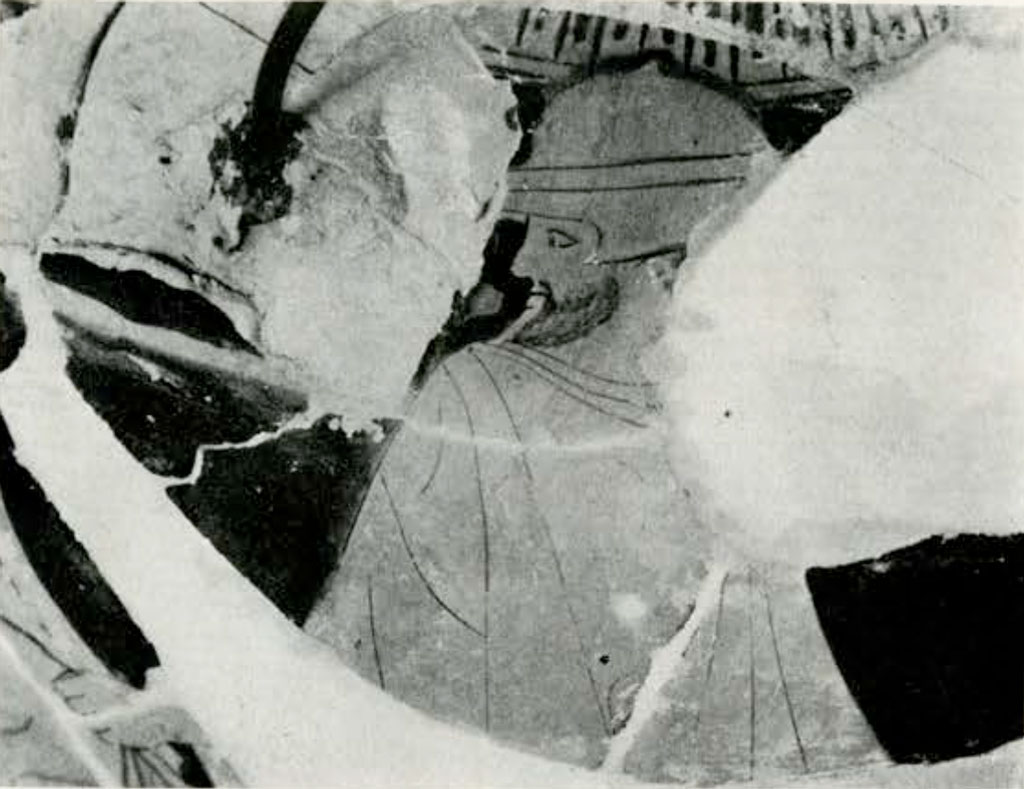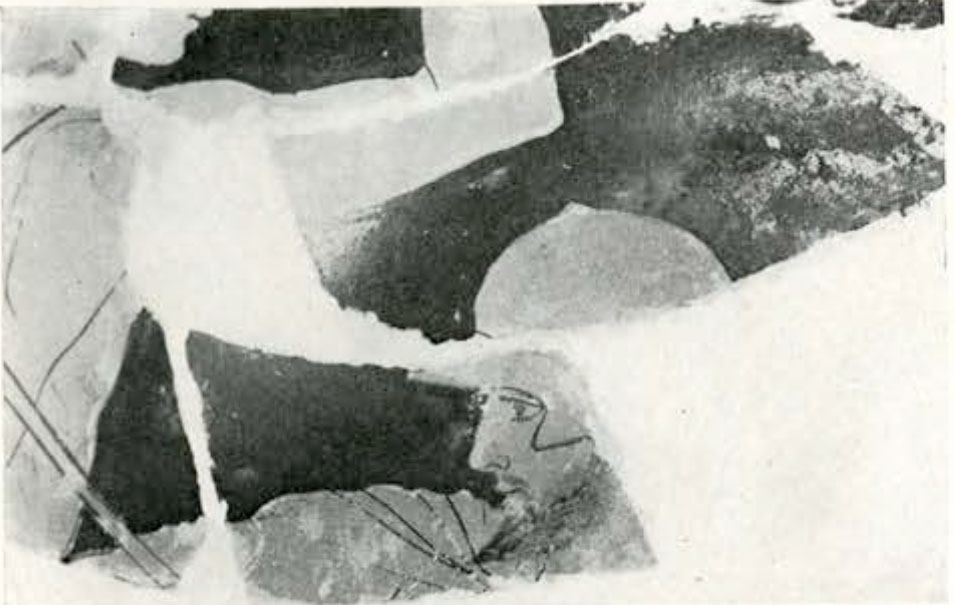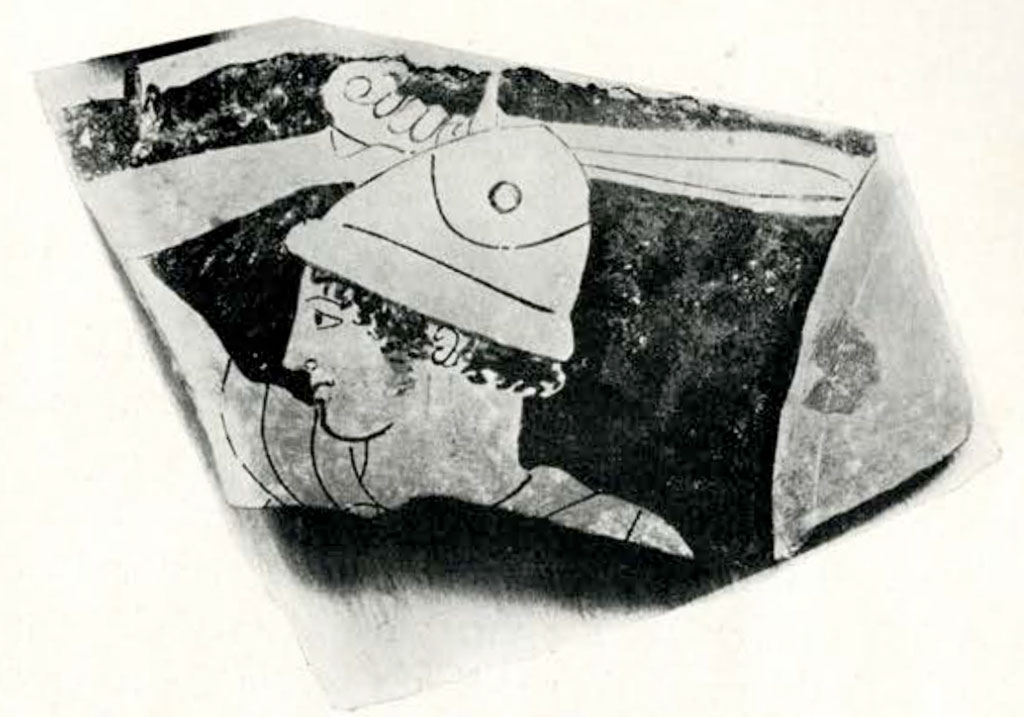THE vase shown in Figures 1 to 17 is said to have been found at Athens. It has been reproduced, inadequately, in a London sale catalogue.1 When it was mending in England, I was able, through the kindness of the then owner, to study it, draw it, and have it photographed. It has now been acquired by the University Museum, and Mrs. E. H. Dohan has generously invited me to give a short account of it in the Journal.

Museum Object Number: 30-4-1
Image Numbers: 2939, 2940
The two general views [Figures 1 and 2] are from Museum photographs; the details [Figures 6 to 17] are from the photographs taken for me by Mr. George Chaundy before the vase was restored: my drawings also [Figures 3 to 5] give only what is ancient.
The vase is a loutrophoros. Vases of this shape had two uses at Athens: at weddings, the water for the bride’s bath was fetched from the fountain Kallirrhoe in such vessels—’loutrophoros’ means simply ‘bath-carrier’; and they were also placed on the tombs of those who had died unmarried.2 The shape is an old-fashioned one: the geometric potter, in the eighth or seventh century, liked to give his vase a long neck which makes it look something like a stork, or a swan, or a goose; and loutrophoroi, from religious and social conservatism, retain this long neck after it has died out elsewhere.
The chief picture on our vase represents a fight, between foot-soldiers and cavalry. Below this is a funeral scene: a long procession of men and youths with their right arms extended in the gesture of farewell to the dead. On the neck of the vase there are two figures, one each side: a young warrior, and a man holding a sceptre. The mouth and the lip of the vase are each decorated with a white wavy line, an ornament traditional in loutrophoroi and derived from the serpent of geometric times. There are white rosettes on the stays which join the thin handles to the neck. The fillets above and below the palmettos on the neck are painted red.
Let us take the minor pictures first. In the frieze below the main picture, the door of a house is shown—the corner of the architrave (restored) can just be seen to the right in Figure 13; to the left of this there are four figures turned to the right; to the right of it several others turned to the left. It is the funeral procession; and the gesture as others have pointed out, is that alluded to by Orestes in the Choephoroe of Aeschylus:
οὐ γὰρ παρὼν ᾤμωξα σὸν, πάτερ, μόρον,
οὐδ΄ ἐξέτεινα χειρ΄ ἐπ΄ἐκϕορᾃ νεκροὓ.
‘. . . nor at thy funeral stretch’d forth an arm.’ As to the two figures on the neck [Figures 1 and 2] they are to be taken together: it is the warrior leaving home, and his father watching him leave. A fragment in New York, the neck of a loutrophoros, shows two such figures side by side, the father laying his hand on his son’s shoulder.3



The execution of the vase is uneven. The painter has stamped the neck-figures—disliking, perhaps, the narrow field. The funeral-frieze is competent but no more. The main picture is on an altogether different level. It is not equally fine throughout: in particular, the head of one rider is done quite summarily, possibly because of its awkward position close up to the handle; and, in the minor group, the rider is over small and the hoplite over large. But the attacking warriors in the major group, and the horse in the minor, are grand. There are two groups, a five and a two. The two consists of a bearded warrior, naked, Attic helmet on head, shield on arm, sword slung round him, running at a horseman with his spear [Figures 5 to 10]. The horseman, lightly bearded, has his shoulders turned towards us, wears chlamys and petasos, holds the reins in his left hand, and wields a spear in his right. Parts of the horseman are missing, and in his opponent, besides right forearm with hand, much of the legs, but the left foot is preserved.4 And now the larger group [Figures 3, 4 and 11 to 17]. It consists of five figures: numbering from our left to right, 1, 2, 3, 4, 5. 1 and 2 form one party; 3, 4, and 5 the other. 1 attacks 3; 2 attacks 3, 4, and 5. On the left, two warriors advancing. First, a bearded man, armed cap-a-pie, with corslet. short chiton, greaves, crested helmet (of the so-called Thracian shape), sword (part of the baldrick remains), and shield: his right arm is raised,5 striking downwards with the spear. On this warrior’s left his young companion advances with raised spear: he is naked; he carries a shield, has a sword slung round him (part of the baldrick remains), wears a crestless Corinthian helmet. He is seen from behind, and his left foot touches the ground with the toes only, or toes and ball. The other three warriors belong to the opposing party. In the middle of the whole group, a bearded man gives ground, looking back: he wears short chiton, chlamys, and petasos; his left leg is bent sharply at the knee, his right leg is extended frontal; warrior 1 is striking down at him. The middle of the retreating figure is missing, but the motive can be reconstructed by comparison with a similar figure on a stamnos in the Vatican.6 The left hand held the scabbard, the lower end of which you can see to the right of the figure: he was drawing his sword. Next comes a horseman, very fragmentary. Parts of the horse’s legs remain; the top of his head; and the loose mane-hairs just above his shoulder, left longish for mounting:7 of the rider, the left foot with half the shank; and part of his breast and neck. The horse is in three-quarter view, both body and head: he starts back, for his master is falling, pierced by a spear. We see a bit of the spear; the wound; and the blood. The shaft must have snapped, for there is no trace of it higher up on the vase. The figure is not easy to reconstruct: to the right of the horse’s mane is part of the rider’s chlamys-covered chest; then, I think, part of his neck, with a brown line on it marking the great sinew, as in the man to the right, then, to the right of the neck and the close chlamys-folds, two areas about which I feel doubtful; and then the modern begins. There are many riders tumbling off their horses in works of the late fifth century or of the fourth, and in works derived from models of that period; but none, as far as I can see, very close to ours. A figure in the principal frieze of the Nereid monument;8 another in one of the friezes of the Trysa Heroon;9 a third in clay plaques which are Roman, but based on classical Greek models;10 a fourth on an Apulian bell-krater in Naples:11 all these resemble ours in some respects, but differ from it in others. The last warrior on the right is bearded, wears chlamys and petasos, and holds his spear at neck-level nearly horizontal: he is seen from behind; he is retreating, but turning round towards the enemy, ready to strike: only the upper third of him remains, hut the attitude must have been something like that of a man on the Themis cup in Berlin12—right leg in profile with the knee bent, left leg extended, with the back of it towards us and the heel off the ground.

Image Number: 2941
The subjects most commonly depicted on loutrophoroi are what one would expect, considering the special functions of this type of vase. Funeral scenes: in the chief place, usually, the prothesis—the dead lying on a couch with mourners round him;13 but sometimes, in the later part of the fifth century, such gatherings at the tomb, or with the tomb represented, as appear on sepulchral lekythoi.14 And scenes connected with marriage: the wedding procession, or the bride admiring the gifts. But a third kind of picture occurs on certain loutrophoroi: battle-scenes, often with cavalry. Such vases must have been placed at the tombs of those fallen in war. The Philadelphia vase, incomplete as it is, is the best preserved of these battle-loutrophoroi, most of the others being extant in fragments only.15 The latest battle-loutrophoroi belong to the end of the fifth century. Our vase is one of the earliest. It cannot have been painted before 450: but it cannot be as late as 430. Somewhere about 440 is the probable date: and there was plenty of fighting in the forties and early thirties to which it might refer. Still earlier than our vase is a fine vase-fragment in Tubingen which, in all probability, comes from a loutrophoros [Figure 19].16 It gives head and shoulders of a young warrior, wearing chlamys and pilos, in the same sort of attitude as the retreating warrior on the Philadelphia vase, but striking at his pursuer with his sword. To the right, the shield of another warrior. Above the youth’s head is part of a handle—from its shape a loutrophoros-handle. Now the style is that of the painter Hermonax,17 and the date cannot be later than 450, and is probably distinctly earlier. The Tubingen fragment, and the Philadelphia vase, show that there were battle-loutrophoroi well before the outbreak of the Peloponnesian War.18 Sometimes a tomb is drawn in the background: this does not mean that the fight is thought of as taking place at a tomb:19 it only says ‘one is buried, or commemorated, here’; and the rest of the picture adds ‘who fell in battle for his country: Elsewhere I have referred to the Attic tomb-reliefs of the time with battle-scenes;20 and to late white lekythoi;21 and might have cited the loutrophoros-fragment in the Hague, on which the polyandrion is represented—the public sepulchre of the fallen—with the names of the fields on which they fell.22

There remains the question, who painted the vase. In the chief picture I find the style of an excellent artist, the Achilles painter, so called from a famous amphora, decorated with a picture of Achilles, in the Vatican;23 and the two attackers in the major group, and the horses, are not unworthy to be put beside his Achilles, or his Euphorbos in the Cabinet des Médailles, or his Satyrs and Maenads in the same collection. In the funeral frieze, however, I do not recognise the hand of the Achilles painter. It is not a question of careful work and careless: we know this artist’s careless work as well as his careful. Compare the funeral frieze with the many draped figures, from the reverses of vases by the Achilles painter, which I have figured in the Journal of Hellenic Studies.24 There are certain resemblances in the type of drapery, but the drawing is quite different. The Achilles painter tends to straight lines and rectangular forms, our painter’s lines swell out and hump. The funeral frieze is, I think, by an assistant or colleague: I conjecture by the Sabouroff painter,25 whom we can see, both in his red-figure work and in his fine white lekythoi, to have been strongly influenced by the Achilles painter.26 The neck-pictures of our vase should also be his. There is nothing inherently improbable in such division of labour: and I have noticed a good number of what seem to me certain instances on vases.27







Image Number: 2942



University Museum
Height .422 Metres
Museum Object Number: 30-51-2
Image Number: 2951

1 Sale catalogue Sotheby, May 27, 1929, pls. 5-6. ↪
2 The classic account of loutrophoroi is by Wolters in Ath. Mitt., 16, pp. 371405. ↪
3 07.286.70: by the painter of the Brussels oinochoai: my Attische Vasenmaler (Att. Vas.), p. 289, No. 3. ↪
4 I took what shows near the lower right-hand corner in Figure 4 to be part of this warrior’s right heel, the foot being extended frontal and the heel off the ground. The remains seem to have been painted over by the restorer. ↪
5 Forearm and hand are missing. My drawing, owing to the difficulty of rolling-out from the curved surface to the flat, has bad to omit the part of the spear which passes on the hither side of the helmet; and the relation between the lower part of his spear, the diaphragm of his companion, and the arms of his opponent, is not what it should be: see the photograph Figure 12. What shows between the legs, by the way, really belongs to the group already described: it is the horse’s tail. ↪
6 Mus. Greg., ii pl. 20, 2: phot. Alinari 35711: by the same hand a stamnos with a departure scene in the collection of Marchesa Isabella Guglielmi at Rome. ↪
7 Compare the horse on the Niobid krater in the Louvre (Furtwängler-Reichhold, Griech. Vasen. pl. 108: Pfuhl Mal. end Zeich. fig. 492). ↪
8 Smith 860: Mon., 10, pl. 13, 37; Brunn-Bruckmann, 214, above: by ‘Master II’ (Schuchhardt, Ath. Mitt., 52, p. 102). Cf. also Smith 862, Mon., 10, pl. 13, 41, by ‘Master l’ (Schuchhardt, ibid, p. 103). ↪
9 Benndorf, Heroon von Gjölbaschi, pl. 15, slab 18 Loewy, Polygnot fig. 78. ↪
10 Von Rohden and Winnefeld, Architektonische Terrakotten der Kaiserzeit, pl. 130. ↪
11 Naples 2409: small photo. Sommer 11072, 6, 2. Riders pulled off their horses occur in the archaic period, for instance in pictures of Achilles and Troilos like that on the Brygos painter’s cup in the Louvre Mon. Piot, 16, pl. 15 Roscher, Lex. der Myth., s.v. Troilos, p. 1226), hut they have not hitherto been seen to become a feature of battle representations till the twenties or the teens of the fifth century. Allied to these (oilers are such wounded figures (not on horseback) as on the shield of Athena Parthenos [Schrader. Zu den neuen Antikenfunden im Hafen des Piraeus in Sitz. Preuss. Ak., 1931, p. 6), or at Trysa (Benndorf, op. cit., pl. 13, slab 14). ↪
12 Furtwängler-Reichhold, Griech. Vasen., pl. 140, to the right in the deer-hunt. By the Codrus painter. ↪
13 Prothesis: see Zschietzschmann in Ath. Mitt., 53, pp. 18-47, and Haspels in Hlídka Archeologická, 1931, pp. 229-232. ↪
14 Athens 1700 (Eph. arch., 1893, pl. 2: by the Kleophon painter) ; the Hague, Scheurleer Museum (woman at the tomb); Athens (Ath. Mitt., 16, p. 381); Heidelberg K 13 (Kraiker, pl. 42, 214); Berlin and (Ath. Mitt., 16, pl. 8) Schliemann collection; Athens, new acquisition (by the same as the last). ↪
15 Athens 13032 (B.S.A., 11, pp. 23940) ; Oxford, 1929, 11 (C.V., Oxford, pl. 66, 27-9); Louvain (see Att. Vas., p. 921, Kleophon painter No. 23); Oxford, 1929, 12 (C.V., Oxford, pl. 66, 30); the Hague (by the Talos painter). The fine Fragments in Tübingen with a dying youth (Watzinger, Vasen in Tubingen, p1. 37, E160) seem to come from a loutrophoros (the white thing is part of a horse, I think, not of a tomb); and other fragments in Tubingen (Watzinger, ibid, E162, E163, E165, E166: Kleophon painter), and two in New York. ↪
16 Watzinger, Vasen in Tübingen, pl. 27, E90. Fig. 19 is from a photograph by my wife, reproduced by kind permission of Prof. Watzinger. Watzinger thinks of the youth as ‘fallen to the ground and supporting himself with his left hand’: but his left hand would not reach the ground-level—the shield shows that; it might have rested, of course, on a rock; but I think the analogy of such figures as the Philadelphia retreater, or those on column-kraters in the Vatican (Mus. Greg., ii, pl. 24, 2; phot. Alinari 35763: painter of Munich 2335) and Syracuse (28928: Notizie degli Scavi, 1907, p. 745: painter of the Naples Centauromachy) give the true attitude. ↪
17 Att. Vas., p. 303, no. 57 ter. ↪
18 Correct therefore my expression in C.V., Oxford, p. 121. ↪
19 Compare Buschor on white lekythoi, Attische Lekythen der Parthenonzeit. ↪
20 C. V., Oxford, text to pl. 66, 27. ↪
21 Riezler, Weissgr. attische Lekythen, p1. 96 and p. 35; C. V., Gallatin, p1. 28, 2. ↪
22 Wolters, Eine Darstellung des Athenischen Staatsfriedhofs in Sitz. Bay. Ak., 1913. ↪
23 A list of his works in my Att. Vas., pp. 371-80 and p. 477, additions in Vases in Poland, p. 49. I make no further additions here, except a lekythos recently acquired by the University Museum, with a young horseman on it (Kunstsammlungen Baron Heyl, ii, p1. 25: now cleaned). (For a reproduction of this vase see Figure 18.] Another lekythos with the same subject and by the same painter is in Athens (1293: no. 62 in my list): no. 63 in my list (Athens 12133), I now see, is but a school-piece. ↪
24 J.H.S., 34, pp. 184-6. ↪
25 A list of his works in Att. Vas., pp. 262.6 and 475.6, additions in Vases in Poland, pp. 32, 34 and 80. For comparison with the youths and men on the loutrophoros, I might quote the Nolan amphora in Copenhagen, C. V., Cop. pl. 151, 2 (no. 31 in my list Att. Vas., p. 264). ↪
26 See Att. Vas., p. 262. ↪
27 These I hope to put together some day: see meanwhile C. V., Oxford, ii, p. vi. ↪

